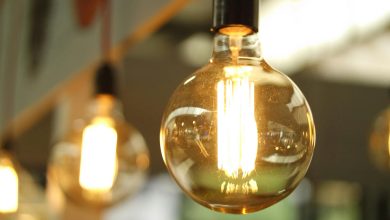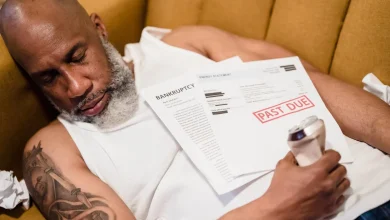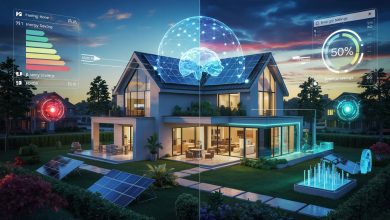Intermediate Guide to Home Energy Tips for 2025
If you’ve ever been shocked by your electricity bill, you’re not alone. After getting a few hefty statements and a nudge from my eco-conscious buddy, I realized it was time to make some changes. The good news? You don’t need to be a genius to save energy at home. With a few simple adjustments and smart choices, you can cut down on your energy use and keep your bills in check. Let’s explore some straightforward home energy tips that can make a real difference without turning your life upside down.
Key Takeaways
- Turn off lights and electronics when not in use to save energy.
- Switch to LED bulbs for better efficiency and longer lifespan.
- Adjust your thermostat a few degrees to cut down on heating and cooling costs.
- Consider upgrading to energy-efficient appliances for long-term savings.
- Look into renewable energy options like solar panels to reduce reliance on the grid.
How to Save Energy at Home
Okay, so you’re ready to cut down on those energy bills? Awesome! It’s not as hard as you might think. I used to ignore this stuff, but after seeing my bill last winter, I knew I had to make some changes. Here’s what I’ve learned so far:
Embrace the Off Switch
Seriously, this is the easiest one. Get into the habit of turning things off when you leave a room. Lights, TVs, game consoles… if it’s not being used, kill the power. I even unplug my phone charger when it’s not charging anything. It’s a small thing, but it adds up. I put a reminder on my phone to do a quick sweep of the house before I leave for work. It helps!
Let There Be (Efficient) Light
Okay, so those old incandescent bulbs? Ditch ’em. LEDs are the way to go. They use way less energy, and they last forever. I’m slowly replacing all the bulbs in my house. It’s a bit of an investment upfront, but you’ll save money in the long run. Plus, you won’t have to change them as often, which is a win in my book.
Thermostat Tweaks
Your thermostat is your friend, but only if you use it right.
- Lower the thermostat a few degrees in the winter when you’re not home or when you’re sleeping.
- Raise it a few degrees in the summer.
- Consider a programmable thermostat. It can automatically adjust the temperature based on your schedule. I got one last year, and it’s made a noticeable difference.
I’ve found that even small adjustments to the thermostat can make a big difference in my energy bill. It’s all about finding that sweet spot where you’re comfortable but not wasting energy.
Vampire Slaying
“Vampire energy” is what I call the power that electronics use even when they’re turned off. Things like TVs, computers, and game consoles are notorious for this.
Here’s how to fight back:
- Unplug devices when you’re not using them.
- Use power strips with on/off switches. This makes it easy to cut power to multiple devices at once.
- Be aware of what’s sucking energy even when it’s “off.”
Level Up Your Energy Efficiency

Ready to take your energy savings to the next level? We’re moving beyond the basics and diving into some intermediate strategies that can make a real difference in your energy consumption and your wallet. It’s time to get serious about efficiency!
Insulation is Sexy (Trust Me)
Okay, maybe sexy is a strong word, but insulation is seriously important. Think of it as a cozy blanket for your house, keeping the heat in during winter and out during summer. Without proper insulation, you’re basically throwing money out the window (literally, if your windows aren’t sealed well!). Check your attic, walls, and crawl spaces. Adding insulation is a project you can often do yourself, or you can hire a professional. Either way, it’s an investment that pays off.
Window Wisdom
Windows can be a major source of energy loss. Single-pane windows? Time for an upgrade. Consider double-pane or even triple-pane windows with low-E coatings. These coatings reduce heat transfer, keeping your home more comfortable year-round. Also, don’t forget about sealing any cracks or gaps around your windows with caulk or weather stripping. It’s a simple fix that can make a big difference. You can also consider window replacement to improve your home’s energy efficiency.
Appliance Upgrades
Old appliances are energy hogs. If you’re still rocking a refrigerator from the ’90s, it’s time for an upgrade. Look for ENERGY STAR certified appliances. These appliances meet strict energy efficiency guidelines set by the EPA. While they may cost a bit more upfront, they’ll save you money in the long run. Plus, many utility companies offer rebates for purchasing ENERGY STAR appliances, so be sure to check those out. Here’s a quick comparison:
| Appliance | Old Model (Approx. Annual Cost) | ENERGY STAR Model (Approx. Annual Cost) |
|---|---|---|
| Refrigerator | $150 | $75 |
| Washing Machine | $100 | $50 |
| Dishwasher | $80 | $40 |
Water Heater Wisdom
Your water heater is another major energy user. Consider these tips:
- Lower the temperature setting to 120°F. Most people don’t need hotter water than that.
- Insulate the tank. You can buy a pre-cut insulation blanket at most hardware stores.
- Insulate the pipes. This will help prevent heat loss as the water travels to your faucets.
Upgrading to a more efficient water heater can also save you money. Tankless water heaters heat water on demand, so you’re not constantly heating a large tank of water. Heat pump water heaters are even more efficient, using electricity to move heat from one place to another, rather than generating heat directly. These options have a higher upfront cost, but they can save you a significant amount of money over the life of the unit.
Adopt Smart Energy Habits

Okay, so you’ve tweaked your thermostat and swapped out your light bulbs. Now it’s time to get serious about your daily habits. It’s easy to fall into energy-wasting routines without even realizing it. Let’s break those bad habits and build some new, energy-smart ones.
Turn Off the Lights When Not in Use
This sounds super obvious, right? But how many times have you left a room and left the light on? Make it a conscious effort to flip the switch every single time. It’s such a small thing, but it adds up over time. I started making a game out of it with my kids, and now they’re light-switch ninjas.
Use Natural Light
Seriously, open those curtains and blinds! Natural light is free, and it makes your home feel brighter and more inviting. On sunny days, try to rely on natural light as much as possible. You might be surprised how much you can reduce your need for artificial lighting. Plus, sunlight is good for your mood! I find that I’m way more productive when I’m working in a naturally lit space. If you are doing some spring-cleaning, make sure to clean your windows to maximize the amount of light coming in.
Limit Appliance Use
Think about how often you use energy-hogging appliances like your dryer, dishwasher, and oven. Can you air-dry your clothes instead of using the dryer? Can you wash dishes by hand sometimes? Can you cook multiple meals at once to reduce oven usage? These small changes can make a big difference.
I started line-drying my clothes in the backyard, and I love it! My clothes smell fresher, and I’m saving a ton of energy. Plus, it’s kind of relaxing to hang clothes on the line. It’s like a little bit of mindfulness in my day.
Utilize Renewable Energy Sources

Okay, so you’re ready to take things to the next level? Let’s talk about renewable energy. It’s not just a feel-good move; it can seriously cut down your energy bills and help the planet. It might seem daunting, but getting started is easier than you think. Plus, there are often tax incentives and rebates that can make the initial investment more manageable. Let’s explore some options.
Install Solar Panels
Solar panels are probably the first thing that comes to mind when you think about renewable energy, and for good reason. They convert sunlight directly into electricity, which you can then use to power your home. The initial cost can be high, but solar power [positive impact](#471b] can save you a lot of money over the long term. Plus, in many areas, you can sell excess electricity back to the grid, earning credits on your bill. Here’s a quick look at what you might expect:
- Reduced energy bills
- Increased home value
- Environmental benefits
Solar Water Heaters
Don’t overlook solar water heaters! These systems use the sun’s energy to heat water, reducing your reliance on traditional water heaters that use electricity or gas. They’re especially effective in sunny climates. A solar water heater can significantly lower your water heating costs, which can be a substantial portion of your overall energy bill. They’re generally less expensive to install than full solar panel systems, making them a good entry point into renewable energy.
Switching to renewable energy sources is a big step towards sustainability. It not only reduces your carbon footprint but also provides long-term cost savings. It’s an investment in your future and the future of the planet.
Monitor and Track Energy Usage
Okay, so you’re making changes, but how do you really know if they’re working? Time to get a little nerdy and track your energy usage. It’s not as scary as it sounds, I promise!
Use Energy Monitors
These little gadgets are super helpful. A whole-home energy monitor connects to your electrical panel and gives you a detailed breakdown of where your energy is going. You can see how much energy each appliance is using, identify energy hogs, and track your progress over time. It’s like a fitness tracker, but for your house! I found out my old fridge was the culprit for a huge chunk of my bill.
Review Your Utility Bills
Don’t just toss those bills in a drawer! Actually, look at them. Compare your usage month to month and year to year. See if you can spot any trends or spikes. For example, did your bill skyrocket in July? Maybe it’s time to check your AC unit. Utility companies often provide charts and graphs that make it easy to visualize your energy consumption. Plus, sometimes they even offer tips tailored to your specific usage patterns.
It’s easy to fall into the trap of thinking you’re saving energy, but without tracking, you’re just guessing. Monitoring gives you concrete data to work with, allowing you to make informed decisions and see the real impact of your efforts.
Here are some things to look for on your bill:
- Total energy consumption (kWh)
- Average daily usage
- Comparison to previous months/years
- Any unusual charges or fees
Advanced Moves for Big Savings
Okay, so you’ve mastered the basics. Now it’s time to bring out the big guns. These options require more investment, but they offer the potential for significant long-term savings and a smaller carbon footprint. Think of it as leveling up your energy game.
Solar Power
Installing solar panels is a major investment, but it can drastically reduce or even eliminate your electricity bills. It’s like having a mini power plant on your roof! The initial cost can be intimidating, but with government incentives and the long-term savings, it’s worth considering. Plus, you’ll feel good about using clean, renewable energy. New legislation offers tax breaks for homeowners who invest in energy-efficient systems.
Smart Home Tech
Smart home technology isn’t just about convenience; it can also save you energy. Smart thermostats learn your habits and adjust the temperature automatically, while automated lighting systems turn off lights when you’re not in a room. It’s like having a personal energy assistant. Here are some examples:
- Smart Thermostats: Adjust temperature based on occupancy and weather.
- Smart Lighting: Dims or turns off lights automatically.
- Smart Plugs: Control appliance usage remotely.
Smart home tech can seem expensive, but the energy savings can quickly add up. Plus, it’s just plain cool to control your home with your phone.
Energy Audit
An energy audit is like a checkup for your home’s energy efficiency. A professional will come in and assess your home’s insulation, windows, and appliances to identify areas where you’re losing energy. They’ll then provide you with a report outlining recommended improvements. It’s a great way to get a clear picture of your home’s energy performance and identify the most effective ways to save money. Consider getting a professional energy audit to identify energy weak spots.
Wrapping It Up: Your Energy-Saving Journey
So, there you have it. Saving energy at home isn’t rocket science. It’s really about making a few smart choices and sticking with them. Whether it’s turning off lights, switching to LED bulbs, or even investing in some solar panels, every little bit helps. You don’t have to do everything at once—start with one or two tips that seem doable. Over time, you’ll see the difference in your bills and feel good about doing your part for the planet. Remember, it’s all about progress, not perfection. Happy saving!
Frequently Asked Questions
What are some easy ways to save energy at home?
You can save energy by turning off lights when you leave a room, using energy-efficient LED bulbs, and unplugging devices when they are not in use.
What is the best energy saving myths debunked
Check this post I have post before Top 5 Energy-Saving Myths Debunked (Stop Wasting Money)
How can I improve my home’s insulation?
Check your attic, walls, and floors for insulation. You can add insulation to keep heat in during winter and out during summer.
What should I look for when buying new appliances?
Look for ENERGY STAR labels on appliances. These appliances use less energy and can help lower your electricity bills.
How can I use renewable energy at home?
Consider installing solar panels or solar water heaters to generate clean energy and reduce your reliance on traditional power sources.
What is an energy audit?
An energy audit is a check-up for your home to find out where you can save energy. A professional can help you identify problem areas and suggest improvements.
How can I track my energy use?
You can use energy monitors to see how much energy your home uses. Also, regularly reviewing your utility bills can help you spot trends and areas for improvement.



